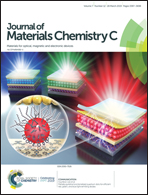Functional microscale single-phase white emission lanthanide MOF for tunable fluorescent sensing and water quality monitoring†
Abstract
Developing novel fluorescent materials to rapidly and reliably differentiate organic molecules and polluting ions in water quality monitoring is highly challenging. Here, by taking advantage of facile preparation and sensitive recognition, a fluorescent platform based on novel microscale heterometallic lanthanide metal–organic framework Eu0.059Tb0.051Gd0.89-DPON (H3DPON = 5-(3,4-dicarboxylphenoxy)nicotic acid) is constructed for effective combination of molecular/ionic recognition and logic computing. The tri-emission lanthanide metal–organic framework (Ln-MOF) exhibits notable fingerprint correlation between various solvent molecules/cations and the emission intensity ratio of ligands, Tb3+ and Eu3+. Furthermore, Ln-MOF shows fast and sensitive recognition of formol in both aqueous solution and vapor. Similarly, an efficient turn-on ratiometric fluorescent probe for VO43− is designed, which is the first application of Ln-MOF as a fluorescent sensor for VO43−. Moreover, Eu0.059Tb0.051Gd0.89-DPON realizes multi-component analysis (Fe3+, VO43−, and S2−) in water via construction of Boolean logic system and obtains a password lock security system by sequential logic operation. The combined merits of outstanding specific surface area and strong molecular/ionic recognition make Eu0.059Tb0.051Gd0.89-DPON a promising material for application in the fields of intelligent multi-component analysis and water quality monitoring.



 Please wait while we load your content...
Please wait while we load your content...